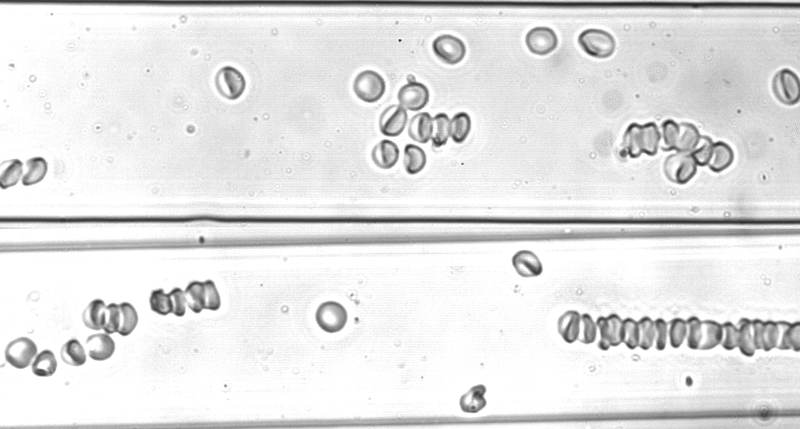- Share
- Share on Facebook
- Share on X
- Share on LinkedIn
Study day / Research
On October 20, 2022

Parabolic flights for the study of blood microcirculation.
Dynamics of red blood cell aggregates under flow in microgravity.
The formation of red blood cell (RBC) aggregates has several origins: (i) a structural alteration (example: glycoproteins) on the surface of RBCs, (ii) the presence in excess of certain enzymes, such as amylase, ( iii) an excess of aggregating proteins (fibrinogen) in the blood plasma. Amylase is overproduced as a result of several diseases (such as pancreatitis). It has also been documented, based on blood tests of Russian cosmonauts, that amylase activity is amplified after a space mission. In order to study the effect of amylase on RBCs under flow we designed an in vitro experiment, in a microfluidic circuit, to analyze the flow of a RBC solution in the presence of amylase and aggregating agents (dextran, a molecule that plays the same role as fibrinogen) with a concentration of dextran in the physiological range. On the ground, when the amylase concentration is in a physiological range, we observe small aggregates, which form and dissociate during the flow. When the amylase concentration increases, mimicking the effect of space missions, or pathologies, the size of the aggregates and their stability increase considerably. However, and this is an essential point, the RBCs and aggregates sediment during the flow in the experiments in the lab, and this introduces serious artefacts in the analysis of the intrinsic effects responsible for the formation of aggregates. It is for this reason that we have recently carried out experiments in microgravity in order to overcome these artefact in order to deduce adequate behavior laws of blood aggregates. Our preliminary results validate the conclusions reached on the experiments performed in the lab. The microgravity experiments were carried out as part of the CNES "National Center for Space Studies" 63/VP167 campaign, the parabolic flights were carried out by the Novespace team.

Mehdi Abbasi and Min Jin performing experiments during the flight.
Testimony of Somnath Santra, post-doct in Eccel :
" Do you want to look at yourself as superman (floating in free air)? If yes, one obvious platform is “Air zero G” flight undergoing parabolic motion. It is very hard to describe the experience in words. In parabolic flight motion, before experiencing zero g (gravity), our body will experience double g. At the time, I felt almost double my weight. And then, for the first time, when I was exposed to zero gravity, it seemed that all my organs except my brain flew away (because I had to take readings). I was not able to take the first reading properly. But, after 3-4 parabolic motions, everything becomes very natural and enjoyable. We successfully and accurately carried out our experiment. It is worth mentioning that, besides our experiment, several researchers from different scientific disciplines came there to pursue their experiment in microgravity. Discussions with them about their studies, their setup, and the most common difficulties faced by them also enriched my knowledge. Lastly, I would like to give my heartfelt thanks to the medical team of Novespace that I did not feel any kind of sickness."
CNES "Centre national des études spatiales"
Novespace.
Date
Parabolic flights, CNES comapaign.
Contact
Chaouqi Misbah
Chaouqi.misbah [at] univ-grenoble-alpes.fr
- Share
- Share on Facebook
- Share on X
- Share on LinkedIn